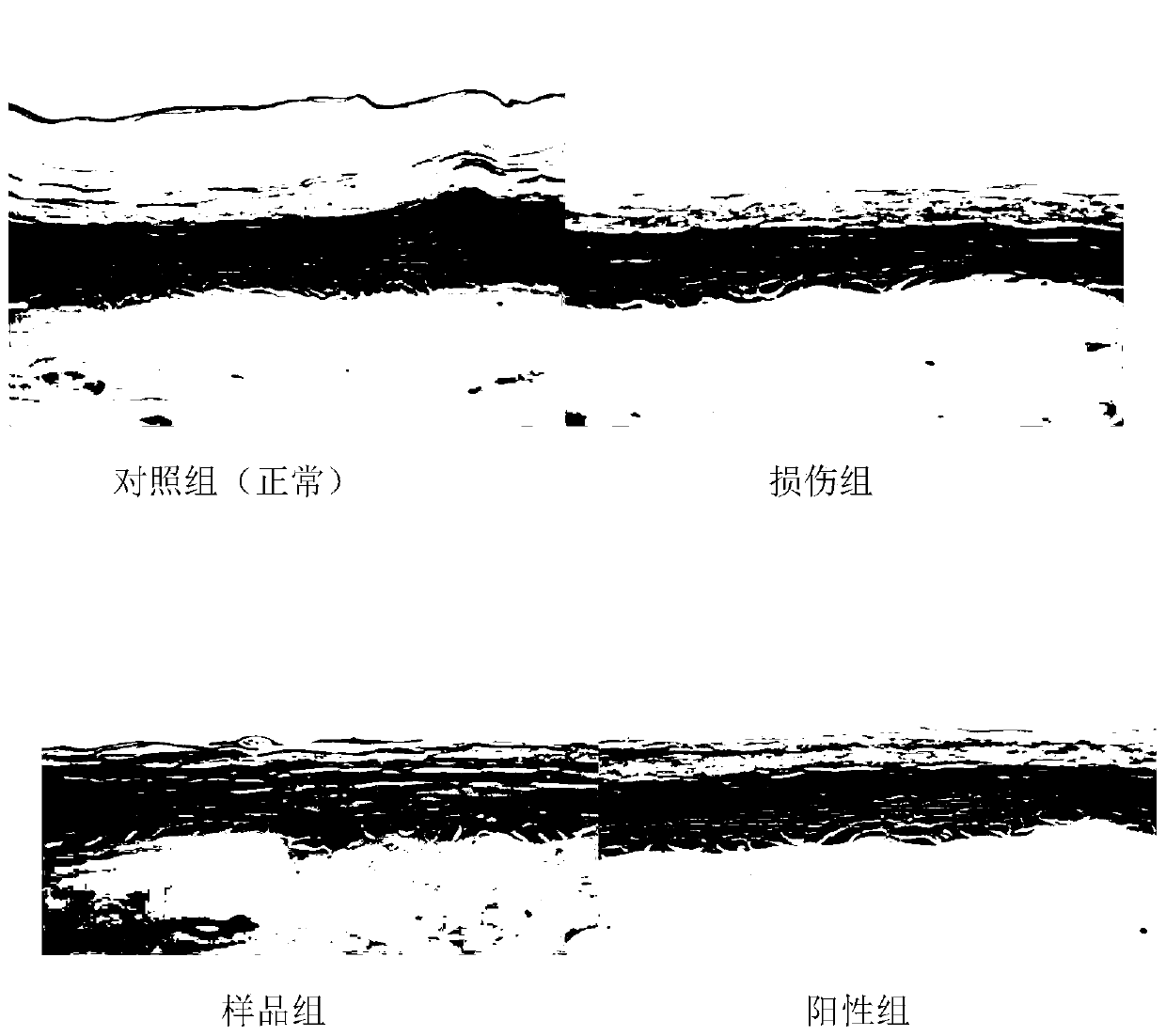In-vitro method for evaluating repair function by reconstructing normal human body three-dimensional skin model
A skin model, human body technology, applied in the direction of material inspection products, measuring devices, instruments, etc., can solve problems such as evaluation methods or standards that have not proposed functions or efficacy, and achieve the effect of increasing credibility and high correlation
- Summary
- Abstract
- Description
- Claims
- Application Information
AI Technical Summary
Problems solved by technology
Method used
Image
Examples
Embodiment 1
[0044] Example 1 Chitosan repair efficacy evaluation based on three-dimensional skin tissue
[0045] 1. Preparation for the experiment
[0046] 1.1 Recombinant human epidermis model kit: purchased commercially (purchased from Shanghai Sianpinuo Biotechnology Co., Ltd., Episkin TM detection kit), equipped with a dedicated maintenance medium.
[0047] 1.2 Sample preparation: Chitosan, as it is.
[0048] 1.3 Other reagents: SDS, PBS, MTT, EGF, isopropanol, ELISA kit.
[0049] 1.4 Incubation conditions: temperature 37±1°C, 5% CO 2 concentration, saturated relative humidity.
[0050] 1.5 Exposure conditions: room temperature, temperature 20-25°C, relative humidity 40-70%.
[0051] 2 Test process:
[0052] 2.1 Preparation of recombinant human skin model.
[0053] 2.1.1 Check the model and discard any visible damage or abnormality.
[0054] 2.1.2 Transfer the model to a culture plate containing 2mL of maintenance medium and incubate overnight.
[0055] 2.2 Test grouping and ...
Embodiment 2
[0085] Example 2 In vitro evaluation of the skin repair function of a basement membrane extract
[0086] 1. Preparation for the experiment
[0087] 1.1 Recombinant human epidermis model kit: purchased commercially (purchased from Shanghai Sianpinuo Biotechnology Co., Ltd., Episkin TM detection kit), equipped with a dedicated maintenance medium.
[0088] 1.2 Sample preparation: basement membrane extract
[0089] 1.3 Other reagents: PBS, MTT, EGF, isopropanol, tissue fixative, hematoxylin-eosin staining solution.
[0090] 1.4 Incubation conditions: temperature 37±1°C, 5% CO 2 concentration, saturated relative humidity.
[0091] 1.5 Exposure conditions: room temperature, temperature 20-25°C, relative humidity 40-70%.
[0092] 2 test process
[0093] 2.1 Preparation of recombinant human skin model
[0094] 2.1.1 Check the model, which meets the quality requirements of the model, and the skin resistance is 60-80Ω, indicating that the skin is not damaged and the barrier funct...
Embodiment 3
[0119] Example 3 Research on skin repair efficacy of trehalose and vitamin E based on three-dimensional skin tissue
[0120] 1. Preparation for the experiment
[0121] 1.1 Recombinant human epidermis model kit: purchased commercially (purchased from Shanghai Sianpinuo Biotechnology Co., Ltd., Episkin TM detection kit), equipped with a special culture medium.
[0122] 1.2 Sample preparation: trehalose and vitamin E
[0123] 1.3 Other reagents: PBS, MTT, fetal bovine serum, isopropanol, IL-1α and TNFα ELISA kits.
[0124] 1.4 Incubation conditions: temperature 37±1°C, 5% CO 2 concentration, saturated relative humidity.
[0125] 1.5 Exposure conditions: room temperature, temperature 20-25°C, relative humidity 40-70%.
[0126] 2 test process
[0127] 2.1 Preparation of recombinant human skin model
[0128] 2.1.1 Check the model and discard any visible damage or abnormality.
[0129] 2.1.2 Transfer the model to a 6-well culture plate containing 1 mL of maintenance medium an...
PUM
 Login to View More
Login to View More Abstract
Description
Claims
Application Information
 Login to View More
Login to View More - R&D
- Intellectual Property
- Life Sciences
- Materials
- Tech Scout
- Unparalleled Data Quality
- Higher Quality Content
- 60% Fewer Hallucinations
Browse by: Latest US Patents, China's latest patents, Technical Efficacy Thesaurus, Application Domain, Technology Topic, Popular Technical Reports.
© 2025 PatSnap. All rights reserved.Legal|Privacy policy|Modern Slavery Act Transparency Statement|Sitemap|About US| Contact US: help@patsnap.com



